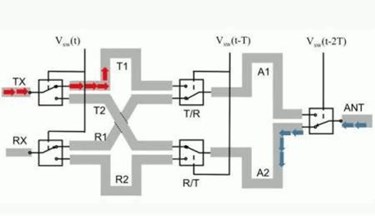UCLA's Electromagnetic Wave Router Offers Unlimited Bandwidth
By Jof Enriquez,
Follow me on Twitter @jofenriq

Electrical engineers at University of California, Los Angeles (UCLA) have developed a new type of circulator that uses a concept called Sequentially-Switched Delay Line (SSDL), which enables the simultaneous use of the same frequency for incoming and outgoing information in a single communications device. The device could reduce demand for bandwidth without sacrificing wireless communication quality.
Traditional circulators have long been used to transmit and receive electromagnetic signals simultaneously. But these bulky devices typically require the use of magnetic materials, which are difficult to integrate with modern integrated circuits. Active circulators, on the other hand, with their smaller size, are more compatible with integrated circuits, at the price of limited noise and power performance, making them unsuitable to handle wide dynamic ranges.
The research team — led by Ethan Wang, associate professor of electrical engineering at the UCLA Henry Samueli School of Engineering and Applied Science — made a novel circulator that overcomes the limitations of typical circulators. Their “distributedly modulated capacitor,” or DMC, consists of non-magnetic materials, such as silicon or compound semiconductor, that acts as a traffic roundabout for electronic signals.
The device, which works across a broad band of the spectrum, shifts the incoming wireless transmission onto another frequency for processing, while leaving the frequency of the outgoing transmission unchanged, according to a news release. More practically, the circulator can easily be incorporated into existing communications devices using current integrated circuit manufacturing processes.
Building upon their earlier research, Wang and colleagues sought to devise a method where the circulator is capable of offering not just wide, but unlimited bandwidth – an exciting proposition as a so-called electromagnetic "spectrum crunch" appears imminent.
In order to route broadband signals simultaneously, the UCLA team devised the time-switching strategy they call the Sequentially-Switched Delay Line (SSDL).
"The essential SSDL configuration consists of six transmission lines of equal length, along with five switches. Each switch is turned on and off sequentially to distribute and route the propagating electromagnetic wave, allowing for simultaneous transmission and receiving of signals through the device. Preliminary experimental results with commercial off the shelf parts are presented which demonstrated non-reciprocal behavior with greater than 40 dB isolation from 200 KHz to 200 MHz. The theory and experimental results demonstrated that the SSDL concept may lead to future on-chip circulators over multi-octaves of frequency," they write in Scientific Reports, a Nature journal.
The SSDL method is analogous to a train traffic management system, controlling the movement of several trains coming in and out of a single train station.
“In a busy train station, trains are actively switched onto and off of tracks to minimize the time they might be stopped to get into and out of the station,” said Wang in a news release. “This is the same idea, only with electromagnetic waves of the same frequency carrying information inside a chip. Just like a capacitor or a resistor, a device capable of routing electromagnetic waves is a fundamental building block in almost any circuit. Making it available with unlimited bandwidth would trigger a revolution in design of mobile phones, automobile sensors or even quantum computers.”
The UCLA team now is testing its SSDL-equipped circulator on specially fabricated chips, using a $2.2 million grant from the Defense Advanced Research Project Agency’s Microsystems Technology Office.
